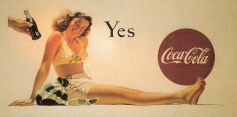Coca-Cola: The Real Thing
|
||
 In the vortex of the 20th century's constant change it has been a source of reassurance to find a few points of stability, a few commodities not subject to the whims of fashion and planned obsolescence. The red and white Coca-Cola logo instantly recognizable, a guarantee of standardization and an emblem of the American Way of life,as potent as the Stars and Stripes itself.
Coca-Cola was the most widely distributed mass-produced item in America when World War II began,and the war provided an opportunity to spread the product into Europe and Asia. lts standardization of experience is both what we admire about its production, and what we occasionally dread about its effects. When European conservatives inveighed against the incursions of crass American values into their ancient cultures, the Coca-Cola logo epitomized all that they resented, and for the young the very act of drinking Coke became a minor form of rebellion against stifling tradition.
Coke's advertising tells us that this carbonated syrup."Is It," although we have not been told what "lt" is. The formula is a long-held, wellguarded secret, and so it should be, because the foaming dark brown liquid is an elixir: Coke "Adds Life". Things, whatever things are, "Go Better" with it. They always did: a 1905 ad declared it to be "a delightful palatable healthful beverage. lt relieves fatigue and is indispensable for business and professional men, students, wheelmen and athletes." Such claims might be disputed,but not for the drink's supreme claim, the perfect ad-line for the perfect product, that Coca-Cola is "the Real Thing". This is a triumph of the American corporation and advertising industry. If Coke is the Real Thing, what can we possibly call artificial or fake?
Source: Dreams for Sale - Popular Culture in the 20th Century - Harrap Books Ltd. London
|
Coca-Cola: The Real Thing
|
|